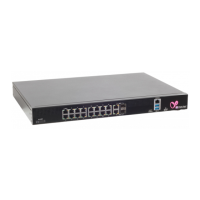
Do you have a question about the Quantum CHECK POINT SPARK 1500 Series and is the answer not in the manual?
| Brand | Quantum |
|---|---|
| Model | CHECK POINT SPARK 1500 Series |
| Category | Network Hardware |
| Language | English |
Overview of the 1500 appliance series, including models and capabilities.
Overview of the 1600/1800 Security Appliances, capabilities, and management.
Step-by-step instructions for physical setup and initial cable connections of the appliance.
Describes various methods for initial deployment and configuration of the SMB gateways.
Steps to connect the appliance to Cloud Services for centralized management and monitoring.
Guide to setting up a guest network with hotspot functionality for controlled access.
Instructions for setting up remote access VPNs using various client options and authentication methods.
Steps to establish secure VPN tunnels between sites using a pre-shared secret for authentication.
Steps to establish secure VPN tunnels using certificates for authentication between sites.
Procedures for setting up a cluster of two appliances for high availability and redundancy.
Steps to configure Quality of Service (QoS) policies for bandwidth management.
Overview of the Home tab in the WebUI, including system information and connection monitoring.
How to enable, disable, and monitor the status and statistics of installed software blades.
Configuration options for managing the appliance locally or centrally via a Security Management Server.
Steps to connect the appliance to Check Point Cloud Services for management and monitoring.
Process for activating and managing appliance licenses for software blades.
Displaying and managing devices identified in internal networks, including blocking and object creation.
Accessing network, security, and troubleshooting information and statistics through the Monitoring page.
Utilizing various system tools for monitoring resources, network, and generating diagnostic files.
Steps to configure single or multiple internet connections, including WAN, DMZ, LAN, and cellular options.
Setting up and managing wireless networks, including guest networks, VAPs, and wireless schedulers.
Configuration of local network connections, switches, bridges, VLANs, and alias IPs.
Procedures for creating and managing clusters of appliances for high availability and redundancy.
Accessing and configuring advanced settings for various blades and system components.
Setting up the default access policy, including firewall rules, application control, and user awareness.
Defining the default access policy modes (Strict, Standard, Off) and configuring outgoing services.
Defining how to handle applications and URL categories, including blocking security risks and inappropriate content.
Enabling and configuring User Awareness for user identification, logging, and policy enforcement.
Managing the Firewall Rule Base, creating, editing, and deleting rules for traffic inspection.
Creating, editing, and deleting server objects for access and NAT policies.
Configuring NAT for outgoing traffic, including Hide NAT and manual NAT rules.
Steps to configure VoIP inspection, including SIP provider settings and on-premise devices.
Activating and configuring IPS, Anti-Virus, Anti-Bot, Threat Emulation, and Anti-Spam blades.
Creating exception rules to bypass SSL inspection for specific traffic handled by IPS and malware engines.
Configuring advanced settings for IPS, Anti-Virus, Anti-Bot, and Threat Emulation engines.
Activating and configuring the Anti-Spam engine to block or flag spam emails based on source or content.
Setting up secure encrypted connections for remote access using VPN clients or SSL Network Extender.
Activating and configuring VPN tunnels for secure site-to-site connectivity.
Adding, editing, and exporting Certificate Authorities (CAs) for VPN and WebUI certificates.
Creating, managing, and uploading appliance certificates for VPN, SSL VPN, and Web portal.
Viewing and reinitializing internal VPN certificates and managing the internal CA.
Enabling and configuring User Awareness for user identification, logging, and policy enforcement.
Creating and managing local users and user groups for access policy and remote access permissions.
Managing local and remote administrators, roles, session timeouts, and QR code generation.
Defining RADIUS and Active Directory servers for user authentication and access.
Defining application groups, custom applications, and URLs for use in the access policy.
Adding, editing, and deleting system services and network protocols for security policy and routing.
Creating, editing, and deleting network objects like IP addresses, ranges, networks, and domains for policy definition.
Accessing and searching the last 100 security log records, with options to refresh and stop logging.
Configuring local and external storage for logs, including SD card formatting and log deletion.
Accessing system logs for troubleshooting, viewing event types, and downloading or saving log snapshots.
Setting up external log servers for security and system logs, including Check Point Log Server and Syslog configuration.
Monitoring current VPN tunnels, their status, and configuration details.
Displaying a list of all active network connections, including protocol, source, and destination details.
Configuring SNMP settings, users, traps, and trap receivers for network monitoring and alerts.
Instructions for upgrading the appliance firmware using a USB drive without a console connection.
Steps to upgrade firmware or auto-configuration files using an SD card on specific appliance models.
Restoring the appliance to its factory default image and settings via WebUI, Boot Loader, or back panel button.
Commands to enable or disable the REST API on the gateway via Gaia Clish.
Details on HTTP POST requests, including URL format, default port, and required headers.
Information on success and failure response structures, including HTTP status codes and JSON content.
Details on common REST API commands like Login, Logout, Generate-Report, and Run-Clish-Command.